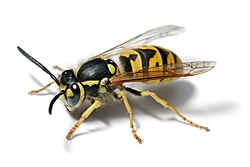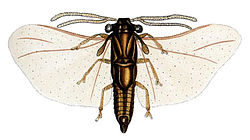Fly
A fly (plural: flies) is an insect of the order Diptera.[1] The Diptera is a large order of advanced flying insects.
| Fly Temporal range: Middle Triassic – Recent
| |
|---|---|

| |
| Hoverfly Syrphus ribesii shows the main dipteran features: large eyes, small antennae, sucking mouthparts, single pair of flying wings, hindwings reduced to clublike halteres | |
| Scientific classification | |
| Kingdom: | Animalia |
| Phylum: | Arthropoda |
| Class: | Insecta |
| Superorder: | Panorpida |
| (unranked): | Antliophora |
| Order: | Diptera Linnaeus, 1758 |
Their most obvious difference from other insects is in their flight. A normal fly has two flight wings on its thorax and a pair of halteres. The halteres, which evolved from the hind wings, act as flight sensors: they are balance organs. Also flies have large eyes with excellent wide-angle vision.
With the help of their eyes and halteres, flies are exceptional fliers. They can avoid most predators, and are among the hardest insects to capture by hand. Their jinks, dives and turns to avoid their predators is their main adaptation.[2] "These flies do a precise and fast calculation to avoid a specific threat and they are doing it using a brain that is as small as a grain of salt".... "And they can fly like an ace at birth. It's like putting a newborn baby in the cockpit of a fighter aircraft and it knowing what to do".[2]
The only other order of insects bearing two true, working wings plus any form of halteres are the Strepsiptera, a small order of insects. In contrast to the flies, the Strepsiptera evolved their halteres from their front wings and their flight wings are their rear wings.
The presence of a single pair of wings distinguishes true flies from other insects with "fly" in their name, such as mayflies, dragonflies, damselflies, stoneflies, whiteflies, fireflies, sawflies, caddisflies, butterflies or scorpionflies.
Some true flies have become secondarily wingless, including some that live in social insect colonies.
Life cycle
Flies are also holometabolous, with complete metamorphosis. This means their eggs turn into grubs, which eat voratious. Then they turn into pupae. Their bodies change while they are in the pupa.
Kinds of flies
There are an estimated 1,000,000 species, although only about 150,000 species have been described.[3]
There are many different kinds of flies. Scientists have named 125,000 kinds (species).[3]
- Houseflies are grey or black and can be found wherever people are.
- Horse flies and deer flies can bite people and animals.
- Fruit flies can be found near fruit that is too ripe.
- Hoverflies look like small wasps, but they have no sting.
Some flies do not have the word fly in their name, so people may not know they are flies.
- Mosquitoes are flies that bite people and can carry diseases, such as malaria.
- Midges are small flies, a bit like mosquitoes, but not all midges bite.
- Gnats are small flies that sometimes are in big groups called swarms.
Some insects have the word fly in their names, but they are not flies at all.
- Fireflies are a kind of beetle that can make light.
- Dragonflies and damselflies are from the order Odonata and are not flies.
Fly Media
An Anthomyiidae species showing characteristic dipteran features: large eyes, small antennae, sucking mouthparts, single pair of flying wings, hindwings reduced to clublike halteres
References
| Wikispecies has information on: Diptera. |
- ↑ from the Greek di = two, and ptera = wings
- ↑ 2.0 2.1 Ghosh, Pallab 2014. Flies can manoeuvre like fighter jets. 'BBC News Science & Environment. [1] Archived 2022-12-06 at the Wayback Machine
- ↑ 3.0 3.1 Mayhew, Peter J. 2007. Why are there so many insect species? Perspectives from fossils and phylogenies. Biological Reviews. 82 (3): 425–454. doi:10.1111/j.1469-185X.2007.00018.x. PMID 17624962.









